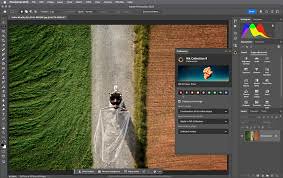Mastering Photoshop: A Beginner’s Guide in 10 Steps
📖 Chapter 1: Introduction to Photoshop
Overview:
Adobe Photoshop is a versatile image editing tool used by graphic designers, photographers, and artists worldwide. From editing photos to creating stunning graphics, Photoshop offers endless possibilities.
In this chapter, you’ll learn:
- What Photoshop is and why it’s used
- Real-world applications: photo editing, advertising, social media content
- Photoshop file types (PSD, PNG, JPG, etc.)
- Difference between raster (Photoshop) and vector (Illustrator)
Why this is important:
Understanding what Photoshop can do helps you visualize how it fits into the broader graphic design and multimedia workflow.
📖 Chapter 2: Understanding the Interface
Overview:
This chapter introduces the layout of Photoshop’s workspace so you can navigate it efficiently.
Topics Covered:
- Menu bar (File, Edit, Image, Layer, etc.)
- Toolbar: Move Tool, Lasso Tool, Crop Tool, Brush Tool, etc.
- Options bar: Contextual settings for each tool
- Panels: Layers, Adjustments, Color, Properties
- Customizing your workspace and saving it
Pro Tip:
You can reset your workspace anytime by choosing Window > Workspace > Reset Essentials.
📖 Chapter 3: Working with Layers
Overview:
Layers allow you to separate elements of your design. Think of them as transparent sheets stacked together.
Topics Covered:
- Creating, renaming, hiding, and deleting layers
- Layer hierarchy and opacity
- Layer groups and folders
- Layer masks for non-destructive editing
- Adjustment layers vs. regular edits
Why it matters:
Using layers efficiently is the secret to clean, editable, and professional designs.
📖 Chapter 4: Selection Tools
Overview:
Selections let you isolate specific parts of an image for editing.
Tools Covered:
- Rectangular and Elliptical Marquee Tools
- Lasso, Polygonal Lasso, and Magnetic Lasso Tools
- Magic Wand and Quick Selection Tool
- Select Subject and Select and Mask options
- Feathering and refining selections
Example:
Want to remove the background of an image? Selection tools are your best friends.
📖 Chapter 5: Retouching Tools
Overview:
Learn how to clean up images and remove unwanted elements.
Tools Covered:
- Spot Healing Brush: Fix small spots and blemishes
- Healing Brush: Copy pixels with texture
- Clone Stamp: Manually duplicate image areas
- Patch Tool: Replace selected areas with other pixels
- Red Eye Tool
Use Case:
Perfect for photographers or anyone editing skin, objects, or dust from images.
📖 Chapter 6: Text & Typography
Overview:
Text adds context to your graphics. This chapter explores how to insert, style, and modify text.
Topics Covered:
- Type Tool and its variants
- Adjusting font, size, weight, spacing (kerning, tracking, leading)
- Warping text into shapes (arc, wave, etc.)
- Creating typographic posters or social media quotes
- Text effects using Layer Styles (drop shadows, strokes, etc.)
Pro Tip:
Convert text to a shape for more control over individual letters.
📖 Chapter 7: Adjustment Layers
Overview:
Adjustment layers help you edit color, brightness, contrast, etc., without changing the original image.
Types Covered:
- Brightness/Contrast
- Levels and Curves
- Hue/Saturation
- Gradient Map
- Photo Filter
Key Features:
- Non-destructive editing
- Use with masks and clipping masks
- Apply to one or multiple layers
Real-world use:
Color correction, vintage effects, or increasing clarity in dull images.
📖 Chapter 8: Filters and Effects
Overview:
Filters add creative effects or modify image textures.
Tools Covered:
- Blur effects (Gaussian, Motion, Lens)
- Sharpen filters
- Liquify (reshape facial features or objects)
- Oil Paint and Artistic effects
- Smart Filters (editing filters non-destructively)
Workflow Tip:
Convert layers to Smart Objects before applying filters for editable results.
📖 Chapter 9: Saving & Exporting
Overview:
Learn how to save your work in the right format and optimize it for the web, print, or social media.
Topics Covered:
- File types: PSD (editable), JPG (compressed), PNG (transparent), TIFF, PDF
- Export As and Save for Web
- Image resolution (DPI: 72 for web, 300 for print)
- Exporting multiple artboards
- Tips for reducing file size without quality loss
Pro Tip:
Always save a copy in PSD before exporting final versions.
📖 Chapter 10: Photoshop Shortcuts & Tips
Overview:
Boost your efficiency by mastering essential keyboard shortcuts and pro tips.
Most-Used Shortcuts:
- Ctrl+Z – Undo
- Ctrl+T – Free Transform
- Ctrl+J – Duplicate Layer
- Ctrl+G – Group Layers
- B – Brush Tool
- [ and ] – Decrease/Increase Brush Size
- Ctrl+Alt+Shift+S – Save for Web
Pro Tips:
- Use layer masks instead of erasing
- Always name your layers
- Practice with real projects (like creating a social media post)

